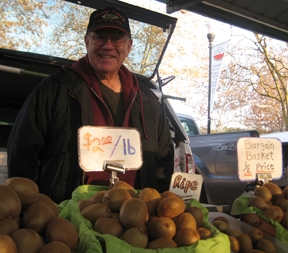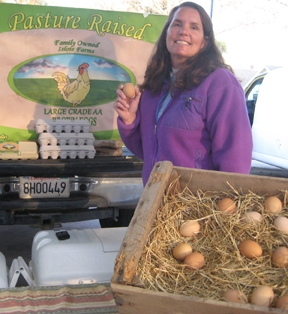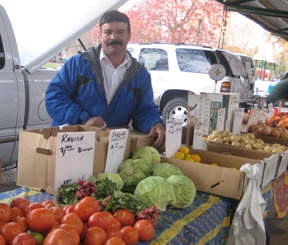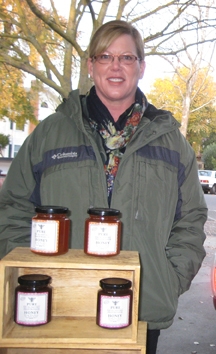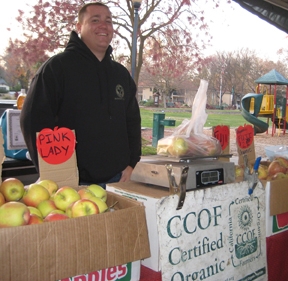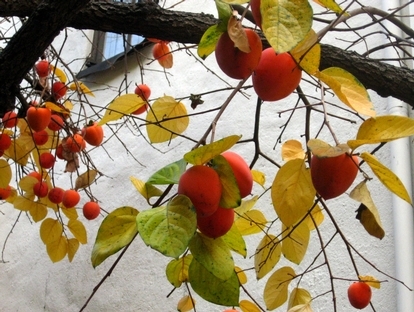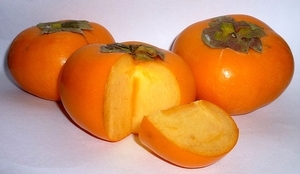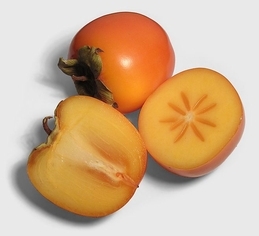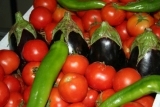Posts Tagged: winter
Did you catch the buzz?
Did you catch the buzz?
It's still a troubling scene for our nation's honey bees, but it appears that the total losses for the 2011-2012 winter aren't as bad as they could be.
In other words, managed honey bee colonies appear to be holding their own. Overall, they didn't take a sharp dive last winter.
The annual survey, conducted by the U.S. Department of Agriculture (USDA), the Bee Informed Partnership, and the Apiary Inspectors of America shows that the honey bee colony losses averaged 30 percent for the winter of 2011-2012.
Compare that to 34 percent for the 2009-2010 winter, 29 percent for 2008-2009 winter; 36 percent for 2007-2008, and 32 percent for 2006-2007.
Kim Kaplan of the Agricultural Research Service (ARS) of USDA wrote in a May 23 news release that 5,572 beekeepers responded to the survey, which covered the period from October 2010 to April 2011. These 5,572 beekeepers, he said, manage more than 15 percent of the country's estimated 2.68 million colonies.
As ARS entomologist Jeff Pettis, who helped conduct the study, said: "The lack of increase in losses is marginally encouraging in the sense that the problem does not appear to be getting worse for honey bees and beekeepers."
Pettis is a familiar name among scientists, beekeepers and the beekeeping industry. He leads the USDA's chief research agency, the Bee Research Laboratory, in Beltsville, Md.
ARS plans to publish a complete analysis of the data later this year, Kaplan reports, but for now, we know that the average losses didn't fall below 30 percent. Some beekeepers, however, recorded much heavier losses.
Why care about the declining bee population?
As author Norm Gary, emeritus professor of entomology at UC Davis, says in his book, Honey Bee Hobbyist; The Care and Keeping of Bees, "Bees play a fundamental role in food production. About one-third of the food we eat, at least in the United States, can't be produced without pollination by honey bees. Fruits, vegetables, berries, some fiber crops, domestic animal feed, and oil seed crops would be in extremely short supply without honey bee pollination."
And almonds. California, the world's largest producer of almonds, has some 800,000 acres of almonds and each acre requires two hives for pollination. Without bees, no almonds.
"Can you imagine the impact on our food supply and diet if honey bees weren't available for pollination?" Gary asks. "Without them, the human diet would consist mostly of grains and fish."
Think wheat, rice and fish.
No honey, either.
Speaking of honey, you might like to try this Cranberry Oat Bread recipe provided by the National Honey Board. It hasn't been a honey of a winter for the nation's bees, but this is a honey of a recipe.
Cranberry Oat Bread
3/4 cup honey
1/3 cup vegetable oil
2 eggs
1/2 cup milk
2-1/2 cups all-purpose flour
1 cup quick-cooking rolled oats
1 teaspoon baking soda
1 teaspoon baking powder
1/2 teaspoon salt
1/2 teaspoon ground cinnamon
2 cups fresh or frozen cranberries
1 cup chopped nuts
Combine honey, oil, eggs and milk in large bowl; mix well. Combine flour, oats, baking soda, baking powder, salt and cinnamon in medium bowl; mix well. Stir into honey mixture. Fold in cranberries and nuts. Spoon into two 8-1/2 x 4-1/2 x 2-1/2-inch greased and floured loaf pans.
Bake in preheated 350 degrees oven 40 to 45 minutes or until wooden toothpick inserted near center comes out clean. Cool in pans on wire racks 15 minutes. Remove from pans; cool completely on wire racks. Makes 2 loaves.

Honey bee heading toward pomegranate blossom. (Photo by Kathy Keatley Garvey)

Honey bee packing pollen while foraging on almond blossoms at the Harry H. Laidlaw Jr. Honey Bee Research Facility, UC Davis. (Photo by Kathy Keatley Garvey)
December farm stories
Davis Wednesday afternoon farmers' market can be quiet in December, so what better time to learn a little about what's going on back at the farms? Every farmer I talked with today had delicious treats to sell and a story to tell. Here are a few:
Did you know that Gridley is the kiwi capital of America? There used to be a kiwi festival and a kiwi queen, but that all got too expensive for Gridley's kiwi farmers quite a few years ago, Frank Stenzel reports. He's getting ready to start pruning his 14 acres of kiwi vines next week; pruning will take a crew of 12 about two weeks. After pruning, each of the 25 or 30 canes on each kiwi vine will need to be tied to a trellis, very much like grape vines, to be ready for next year's growth.
The fuzzy green fruit for sale today from Stenzel's Kiwi Farm was harvested late in October and has been held in cold storage at 32 degrees since then. The fruit will last about six months stored this way, allowing Stenzel to bring out what he needs, grade it by size, let it ripen a little, but sell it while it's still firm. When you bring your kiwis home, let them ripen three or four days more for the best flavor.
Now that the weather is getting colder, the older chickens at Annette Jones' Islote Farms in Esparto have started molting. For a few weeks, they will lose feathers and stop laying eggs. But Jones isn't worried; in fact, she planned for this. Younger hens are picking up the slack because they hatched later in springtime and are just starting to lay eggs in December and January. The older hens can take their much needed break while the youngsters get busy. The fresh eggs from the younger hens are available at the market today in small and medium sizes. When springtime comes, all the birds will be laying again and eggs will be plentiful.
On Federico Toledo's Toledo Farm in Lodi, his son, brother, brother-in-law and other family members are busy planting this month - cabbages, broccoli, cauliflower, spinach, beets, cilantro, carrots, onions and curly parsley. What they're planting now will be at the farmers markets in March, April and May, if the weather cooperates. The 20 long rows of onions going in now will yield green onions in February and March, full-size fresh onions in April and May, and then dry onions in June and July. Today's market table has stories too: The last red tomatoes of the year are for sale today; they were picked green in November and ripened with a heater. The winter squash was actually grown in summer and harvested in August - it gets sweeter over the months and keeps well in winter. The persimmons, grapefruit, lemons and apples were all fresh-picked by the farm family.
All the rice has been harvested now at Robin Harlan's Bullfrog Farms in Winters, and the 3,000 hives of Bullfrog Bees are getting pollen patties to make it through the winter since there aren't enough blossoms to keep them fed without help this time of year. There's time now for bottling the honey; it's been stored in big stainless steel barrels since the Harlans harvested it in the summer. Bullfrog Farms grows more than 200 acres of almond trees which start blooming in January, so the bees will have blossoms very soon to pollinate and pollen to gather for more honey. After working in the Bullfrog orchards, they'll go to Blue Diamond almond orchards, and then to orange groves in Winters. Local honey is the sweet result of these hard-working bees.
Todd Evans works at certified organic Mount Moriah Farms in Clements. Today he's selling crisp Fuji and Pink Lady apples. Up until two days ago, Evans, farm owner Steve Smit, and a couple of other guys were harvesting apples. Now they're getting ready to prune all the trees, which will take the four of them about a month. The apples should last in storage until about May, just long enough for the cherries to be ready.
Give it a try - visit your local winter farmers market and learn some new stories!
To find farmers' markets in your community, visit the UC small farm program's California Agriculture Tourism Directory.
Getting to know persimmons
On a wet and gloomy winter afternoon, there are few sights more cheering to my eyes than a persimmon tree loaded with its brilliant fruit, hanging from dark boughs like a mass of orange lanterns. But if you come across this bright spectacle on a winter's walk, don't rush to take a bite of that tempting fruit unless you're sure you know what's what.
See, there are persimmons, and then there are persimmons.
The type of persimmon that you can eat right off the tree is the Fuyu variety (left), a firm-fleshed, yellow- to orange-skinned fruit that is flat on the bottom and wider than it is tall—sometimes twice as wide. You can eat the fresh, sweet fruit like an apple or cut up in salads or you can dry it on the stem or cut in slices for a home dehydrator.
The fruit of the other main variety, Hachiya (right), is far from sweet when its flesh is firm. Hachiyas are orange to almost red, often somewhat pointed at the bottom, and about as tall as they are wide, sometimes taller. If you bite into one of these before it ripens, your mouth may stay puckered for week. If you can wait until the flesh is soft, though—almost as squishy as a water balloon—you will find something inside that's almost like ready-made jam. Just don't eat any of the peel if you don't want a pucker. You can dry Hachiya persimmons, hung from a cut-off bit of stem, or bake the fresh, ripe fruit pulp in a variety of recipes. Here's one:
Aunt Pat's Persimmon Cookies
This recipe for Hachiya persimmon cookies has been in my family for generations and is always a special treat in the cold months. The cookies have a moist, cake-like consistency and can be eaten fresh or bagged up by the dozen and stored in the freezer. They're quick to thaw and they taste great. We usually make a double or triple batch just to take advantage of the fruit's availability, so cookie storage can be an issue.
CREAM TOGETHER:
1 cup sugar
1/2 cup (1 stick) butter or margarine
LIGHTLY BEAT AND ADD:
1 egg
ADD:
1 cup Hachiya persimmon pulp (about 3 ripe [very soft] persimmons)
1 cup raisins
1 cup chopped walnuts
SIFT TOGETHER AND THEN ADD:
2 cups flour
1 teaspoon baking powder
1 teaspoon baking soda
1/4 teaspoon salt
1/2 teaspoon cinnamon
1/2 teaspoon ground cloves
Drop the dough in generously rounded teaspoonfuls on a greased cookie sheet and bake in a pre-heated 350° oven for 12 to 14 minutes.
More on Persimmons
Check out these links for more information on preserving, preparing, and growing persimmons:
- Persimmon Time (San Joaquin County Cooperative Extension)
- The California Backyard Orchard
(Photos: Wikimedia Commons)
Free information on food: Nutrition, food handling, safety, cooking, etc.
Mention that something is free and useful, and most of us will stop to take a look. And for good reason — the University of California has a number of websites that offer free information related to food.
Take your time to peruse the sites listed below. There is some fascinating and very handy information to be had. Many of these sites also offer terrific publications at nominal prices, but this blog lists only those that are free . . . and we all love a bargain! Many more publications and programs are available than those listed below.
After looking at these lists, you never know when you’ll be inspired to pickle some olives or field dress a deer. As for me, my latest food craze is cheese-making. Two weeks ago I made goat cheese (chèvre, to be sure), and last weekend I made camembert and blue cheeses. Now I just have to be patient for two months while they ripen . . .
Bon appétit and healthful eating!
UC Agriculture and Natural Resources publications [link]
- Tomatoes: Safe methods to store, preserve, and enjoy [link]
- Olives: Safe methods for home pickling [link]
- Egg basics for the consumer: Packaging, storing, and nutritional information [link]
- Guidelines for food safety during short-term power outages: Consumer fact sheet [link]
- Key points of control and management for microbial food safety: Edible landscape [link]
- Safe handling of fruits and vegetables [link]
- Safe methods of canning vegetables [link]
- The healthy brown bag: 15 lunches for school-aged children [link]
Postharvest Technology Research and Information Center [link]
- Storing fresh fruits and vegetables at home – poster (first copy free) [link]
Fruit and Nut Research and Information Center [link]
- The Backyard Orchard – A plethora of publications on growing and harvesting in the home orchard [link]
Nutrition publications from UC Davis [link]
- Nutrition and health information sheets on everything from energy drinks to osteoporosis to anemia, and more [link]
- EatFit - An interactive web program to aid middle-school students in personal dietary analysis and "guided goal setting" [link]
- “Nutrition Perspectives” newsletter - Research-based information on ongoing nutrition and food-related programs [link]
- “Nutrition to Grow On” - A curriculum for grades four through six that offers teachers a direct link between the garden and nutrition education [link]
Food Safety Videos
- Take a look at these humorous — but serious — music videos on food safety by renowned food safety expert Dr. Carl Winter. Who knew that the Beatles’ classic “I Wanna Hold Your Hand” could morph into “You’d Better Wash Your Hands”? [link]
- More food safety music [link]
Cooperative Extension Offices [link]
- Many county offices have publications on food production that is specific to climatic or regional needs of that county.
Publication of the Day!
- Protecting food safety when shooting, field dressing, bringing a deer home, and cutting the carcass [link]
Rocking to food safety music
Carl Winter has been called the “Elvis of E. coli” and the “Sinatra of Salmonella,” but you won’t find him headlining a lounge act in Las Vegas. Instead, the UC Davis food toxicologist crosses California – and the United States – to sing about a subject near and dear to him: food safety.
Combining science-based information with a synthesizer, Winter performs food safety music parodies such as “You Better Wash Your Hands” (from the Beatles’ “I Want To Hold Your Hand”) and “Don’t Be a Gambler” (from Kenny Rogers’ “The Gambler”). He also has created animated food safety music videos such as “Stomachache Tonight,” a parody of the Eagles’ “Heartache Tonight” that, ironically, recounts a time he got sick in Georgia while on tour performing about food safety.
Although a lot of food safety information exists already, food safety music is a great way to supplement the message, said Winter, who has produced parodies for nearly 15 years and distributed more than 20,000 copies of his CDs with songs about food safety, nutrition and pesticides. “We found people retain information better through music,” Winter said.
Food safety is a timely topic. The Food and Drug Administration just held meetings April 26 and 27 in Monterey County to discuss plans to develop a nationwide produce standard for growing, harvesting and packing fruits and vegetables. Foodborne diseases cause about 76 million illnesses in the United States each year, according to an estimate by the Centers for Disease Control and Prevention.
“We need to understand the science better,” said Winter, who directs UC Davis’ FoodSafe program. “We need to communicate better.”
Winter is doing his part to spread the word about food safety. He is in the middle of putting together a new CD for kids, with songs such as “Who Left the Food Out?” – a parody of the Baha Men’s “Who Let the Dogs Out?” – as well as some original music.
The lyrics may change, but the message remains the same: Wash your hands, avoid cross contamination, cook meat to proper temperatures and refrigerate leftovers promptly. It’s important to eat a balanced diet and take as much control over your foods as you can, Winter said. Eat fruits and vegetables – just wash them first. And enjoy Winter’s songs. For more information, visit Winter’s home page at http://foodsafe.ucdavis.edu and his YouTube page at www.youtube.com/foodsafetymusic.


